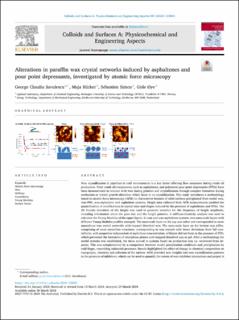| dc.contributor.author | Savulescu, George-Claudiu | |
| dc.contributor.author | Rücker, Maja | |
| dc.contributor.author | Simon, Sebastien Charles Roger | |
| dc.contributor.author | Øye, Gisle | |
| dc.date.accessioned | 2024-04-09T07:41:39Z | |
| dc.date.available | 2024-04-09T07:41:39Z | |
| dc.date.created | 2024-04-08T13:26:13Z | |
| dc.date.issued | 2024 | |
| dc.identifier.issn | 0927-7757 | |
| dc.identifier.uri | https://hdl.handle.net/11250/3125405 | |
| dc.description.abstract | Wax crystallization in pipelines in cold environments is a key factor affecting flow assurance during crude oil production. Polar crude oil components, such as asphaltenes, and polymeric pour point depressants (PPDs) have been demonstrated to interact with wax during gelation and crystallization through complex formation during nucleation or crystal growth alteration which leads to co-crystallization. This study introduces a methodology based on atomic force microscopy (AFM) to characterize features of solid surfaces precipitated from model wax, wax-PPD, wax-asphaltene and asphaltene systems. Height data collected from AFM measurements enabled the quantification of modifications in crystal sizes and shapes induced by the presence of asphaltenes and PPDs. The 2D Fourier transform of the height was used to generate statistics for the frequency of height amplitude, revealing information about the pore size and the height patterns. A stiffness/elasticity analysis was used to calculate the Young Modulus of the upper layers. In wax and wax-asphaltene systems, two nano-scale layers with different Young Modulus profiles emerged. The nano-scale layer on the top was softer and corresponded to more amorphous wax crystal networks with trapped dissolved wax. The nano-scale layer on the bottom was stiffer, comprising of more crystalline structures, corresponding to wax crystals with lower deviations from full crystallinity, with properties independent of asphaltene concentration. A bilayer did not form in the presence of PPD, which prevented the formation of amorphous phases with trapped dissolved wax or gel. After a methodology for model systems was established, the focus moved to systems based on production wax i.e. recovered from deposits. This was complemented by a comparison between model precipitation conditions and precipitation by cold finger, resembling industrial processes. Results highlighted the effect of change in chemical composition on topography, elasticity and adhesion of the surface. AFM provided new insights into wax crystallization patterns in the presence of inhibitors, which can be used to quantify the extent of wax-inhibitor interactions and project it on production systems. The method could be used to explain macro-scale rheological properties of oils during flow assurance in the future. | en_US |
| dc.language.iso | eng | en_US |
| dc.publisher | Elsevier | en_US |
| dc.rights | Navngivelse 4.0 Internasjonal | * |
| dc.rights.uri | http://creativecommons.org/licenses/by/4.0/deed.no | * |
| dc.title | Alterations in paraffin wax crystal networks induced by asphaltenes and pour point depressants, investigated by atomic force microscopy | en_US |
| dc.title.alternative | Alterations in paraffin wax crystal networks induced by asphaltenes and pour point depressants, investigated by atomic force microscopy | en_US |
| dc.type | Peer reviewed | en_US |
| dc.type | Journal article | en_US |
| dc.description.version | publishedVersion | en_US |
| dc.source.journal | Colloids and Surfaces A: Physicochemical and Engineering Aspects | en_US |
| dc.identifier.doi | 10.1016/j.colsurfa.2024.133843 | |
| dc.identifier.cristin | 2259855 | |
| cristin.ispublished | true | |
| cristin.fulltext | original | |
| cristin.qualitycode | 1 | |

